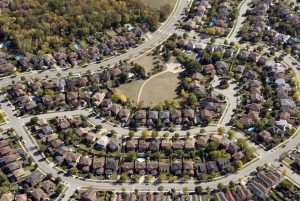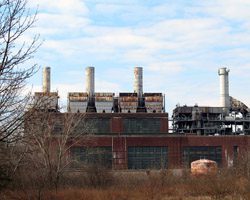If you need Phase I Environmental Site Assessment (Phase I ESA) assistance as discussed in this article, call us at 973-366-4660 or email us at info@atlenv.com for details and a free estimate.
Written By: Robert E. Sheriff, MS, CIH, CSP, President
November 1, 2018, Updated April 2019
A Phase I Environmental Site Assessment (Phase I ESA)
A Phase I Environmental Site Assessment (Phase I ESA) is used to determine the liability to property buyers or financial institutions during mergers and acquisitions, refinancing of commercial real estate, and other situations in order to identify the environmental risks of a site and satisfy the “due diligence” efforts to identify any liabilities associated with the property. In short, “Is the property I am buying or financing have conditions that could adversely affect the property value or be very expensive to correct?” There are a variety of names for this process besides a Phase I ESA. Sometimes referred to as a Commercial Property Assessment, a Pollution Liability Inspection, even a due diligence report. Often a Phase 1 ESA is required by the lending institution providing the funding for a purchase or refinancing.

A Phase I Environmental Site Assessment (ESA) follows the American Society of Testing and Materials (ASTM) guidelines known as ASTM-E-1527-13 Standard for Phase One ESAs and satisfies the “Due Diligence” process in a real estate or financial transaction. The “Due Diligence” requirement comes from CERCLA – the Comprehensive Environmental Response Compensation and Liability Act also known as the Superfund Act. It was intended to provide for clean-up of hazardous waste sites and define what process is necessary to say a property is free of Recognized Environmental Conditions (REC’s).
This ASTM-E-1527-13 standard is intended for Commercial Properties to identify possible environmental risks of unknown or unforeseen conditions of a particular site and surrounding sites that may adversely affect the property value or pose a liability on a property owner, purchaser or financier. Only a Phase I Environmental ESA will satisfy the liability protection under CERCLA for “recognized environmental conditions”. This commercial property assessment satisfies the “due diligence” provisions of CERCLA.
ASTM defines “recognized environmental condition” as the presence or likely presence of hazardous substances and petroleum products on a property under conditions that indicate an existing release, a past release or a material threat of a release into the ground, groundwater or surface water.
Who Needs a Phase I Environmental Site Assessment (ESA)?
Federal, state and local laws make the current and prior property owners liable for the cost of cleaning up contaminated soils, groundwater, surface water, and hazards within structures or the property (such as lead, asbestos, chemical spills, oil, and fuels). If you are buying – or financing – a property, you would want to know if any contamination or hazardous conditions exist on a property before the transaction since you may be paying the cost of clean-up. Clean-up may not just be on your property but any other property including surface and groundwater that may have originated on your property.

A Phase I ESA provides the appropriate level of “due diligence” in the transaction.
A Phase 1 ESA that conforms to the appropriate level of “due diligence” as specified in ASTM-E-1527-13 includes the following:
- Thorough database/records review of all available sources in federal, state, county and municipal records of recognized environmental conditions.
- Historical land use research.
- Site inspection including surrounding properties.
- Interview with the property owner, occupants and possible neighbors.
- Documentation questionnaire.
- Obtaining any previous Phase I ESA, Business Plans, Permits or any other documents that may have environmental significance.
- Photographs of property and surrounding property.
- Geologic characteristic of property, soils, surface, and groundwater (i.e. 7.5-minute topographic maps).
- Aerial photographs and Sanborn Maps as available.
- Other relevant documents such as tax maps, title records, zoning, and land use records, building department records (as reasonably available).
- Records review of environmental records at county and state level (NEW).
- A comprehensive report outlining findings of all above items.
The comprehensive Phase I ESA Report will identify all known or suspected hazardous material or petroleum product releases with recommendations for sampling/testing and analysis (referred to as Phase II) and/or remediation/clean-up (Phase III).

Often Phase II or Phase III recommendations are not possible until the previous phase has been completed. Thus a Phase II soil, groundwater or surface water sampling/testing and analysis cannot be developed until the Phase I Environmental Site Assessment (ESA) has been completed. Likewise, a Phase III – clean-up remediation cannot be developed until Phase II Testing is complete.
Some of the most unlikely items found during a Phase I ESA are (but not limited to):
Underground storage tank (UST) spill or leakage from gas stations or commercial fuel tanks.
Surface and subsurface contamination due to commercial activities as chemical production, junkyards, service stations, leaking surface contaminants.
Stack or uncontrolled air emissions that settle on soil, drainage area, or surrounding properties.
Illegal dumping of waste material including chemicals, fuels, oils, asbestos, lead, and radioactive materials.
The most common reasons for a Phase I ESA include:
- Purchase or sale of a property.
- Financing of a commercial property.
- Re-Financing or second mortgage of a commercial property.
- Change in use of property such as from farmland to school/daycare/playground/park/golf course etc.
- Evidence of clandestine (illegal) dumping, spills.
- Follow-up after the flood where sewerage, chemical, or fuel release is suspected.

What does a Phase I Environmental Site Assessment (ESA) Cost?
There is a wide varied of costs to perform a Phase I ESA. As you may have guessed, there is a wide variety of quality on such ESA. Honestly, you get what you pay for!
The ASTM requirements for a Phase I, the most recent of which is ASTM-E-1527-13. This is a rigid protocol and to protect the property owner, buyer, or lending institution. This “due diligence” protocol must be followed rigidly. It is almost a certainty that a price of $1,000 will not rise to the level of quality to satisfy the ASTM requirements and protect you with “due diligence” requirements as well.
It is our belief that the lowest cost to do an ASTM valid and “due diligence” Phase I is in the range of about $2,000 to $4,000 unless it is an unusually large property or has a strong suspicion of environmental contamination (landfill, gas station, factory) There is a reasonable ceiling amount for a Phase I as well. Remember it is only an assessment of the property and buildings and the possible impact of the neighbors. It is not a thorough building inspection. From experience, the maximum, except for extremely large or complex properties is about $6,000 and this is unusual and rare.
As an ethical matter, Atlantic Environmental, Inc. generally recommends a Full Phase I Environmental Site Assessment according to ASTM-E-1527-13 rather than the more limited Pre-Phase I according to ASTM-E-1528-06 known as a “transaction screen.” It is our belief that a transaction screen does not fully satisfy the “due diligence” requirement under CERCLA.
For further details, quotes or references, please contact us directly at 973-366-4660, e-mail us at info@atlenv.com or use our contact form.
Our primary service areas for Phase I Environmental Site Assessment (ESA) in compliance with ASTM-E-1527-13 are: NJ, NY, NYC, PA, CT, DE, (Boston) MA, RI, Wash DC, WI, MD, MI, (Chicago) IL, VA, IN, (Atlanta) GA, AL, NC, SC, TN, (Dallas, Ft Worth) TX, OK, DC, AR, we can service most other areas of the U.S. but with some added travel charges.



